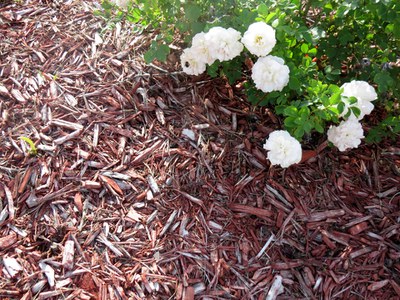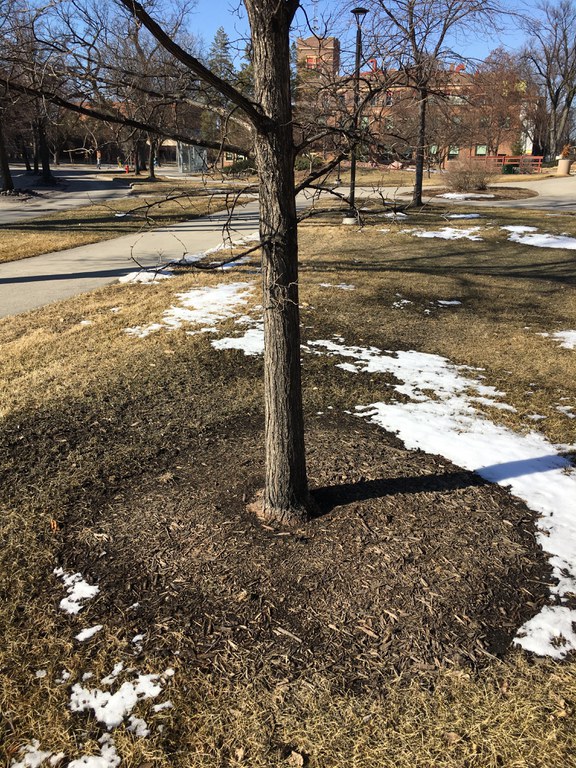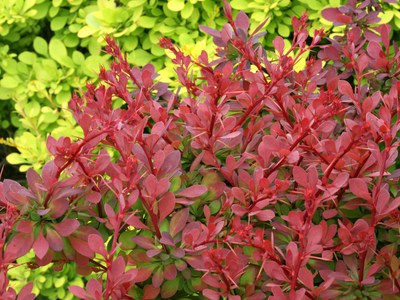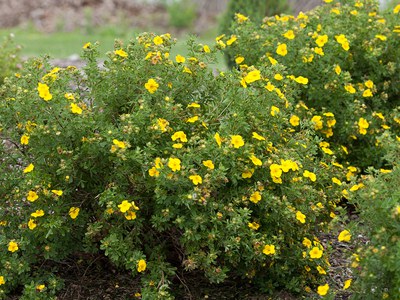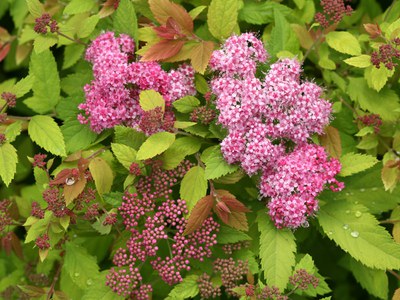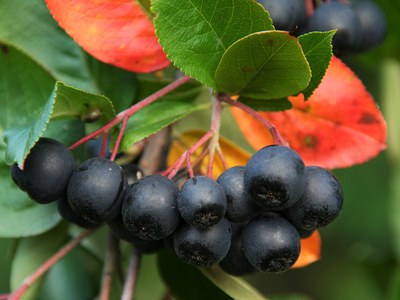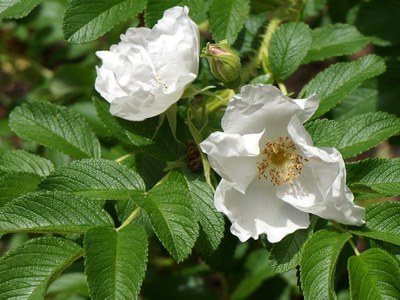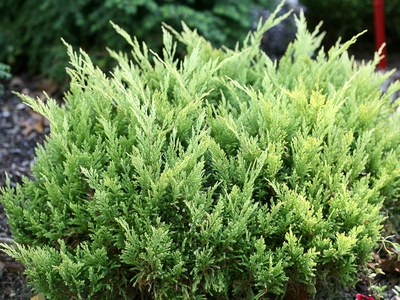Documents
Mulch Madness
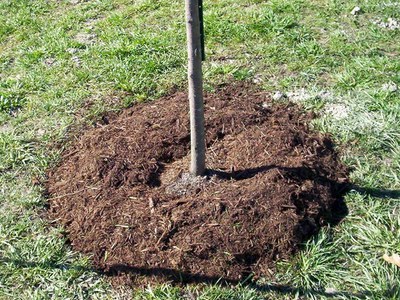
Do you enjoy torturing plants? If yes, get some rock mulch and place it around your plants.
Rock mulch does nothing for a plant. A rocky bed may look good to us, but the plants are suffering. Use shredded bark instead. It’s better for many reasons:
Shredded bark will moderate soil temperatures. Shredded bark will keep a plant cooler during summer and warmer during winter. Perfect!
Rock mulch is a heat trap. It will scorch plants during the summer and make plants uncomfortable in winter, too. The heat generated from mulch in late winter can lead to buds opening too early and later dying from spring frosts. Rock mulch may lead to premature death of heat-sensitive plant such as birch, mountainash and hosta.
Shredded bark enriches the soil. Shredded bark enhances soil structure, leading to an aerated soil that can hold onto nutrients and moisture. Although there can be a short-term loss of nitrogen, the bark will eventually compensate for this and add more nutrients.
Rock mulch harms the soil. Its weight compacts the ground and destroys air pockets needed for roots to grow. Rocks add no nutrients to the soil.
Shredded bark shields plants from physical damage. Both shredded bark and rock mulches shield plants from lawn mowers, but the jagged edges of rock mulch can harm tender tree and shrub trunks.
Shredded bark reduces drought stress. Both shredded bark and rock mulches conserve moisture, but the heat generated from rock mulch creates greater drought stress on the plants.
Rock mulch is terrible for plants—so why do we use it?
Some gardeners are frustrated that shredded bark can blow away. In windy areas, use a finely shredded bark to minimize the blowing away of mulch.
Some gardeners worry about weeds growing in shredded bark. True, shredded bark will allow more weeds compared to a barrier consisting of rocks and landscape fabric and rocks. But neither mulch will prevent all weeds.
Weeds growing in mulch are generally sparse and pull out easily. Under severe infestations, a spray of However, weeds in shredded bark are generally sparse and pull out easily. A spray of glyphosate once a year may be applied to control tough weeds like quackgrass in beds.
Shredded bark mulch is wonderful for plants. To properly apply it, use the “3-3-3 Rule.” Apply shredded bark in a circle at least 3 feet wide; the wider the better. Take the mulch all the way out to the dripline, if you want.
The mulch should be kept away at least 3 inches away from the trunk and gradually increase in depth to about 3 inches around the edge of the mulch ring.
The next time you plant a tree or shrub, show it some love and surround it with shredded bark. You will be rewarded with a happy, healthy plant.
Written by Tom Kalb, Extension Horticulturist, North Dakota State University.
Coping with Drought
North Dakota is in a drought. Much of our state has been dry since last summer. This is not our first drought, and it won’t be our last. Here are some tips to cope with dry times.
Mulch Everything. Exposed soil can lose twice as much moisture as mulched soil. Use wood mulches around trees, shrubs and flowers. Rock mulches are less effective. Use straw/ hay or plastic mulch in veggie gardens.
Prioritize Your Watering. Your young trees and shrubs suffered damage to their root systems when they were transplanted. These "shocked" plants are most vulnerable to drought stress. These plants are probably the most valuable plants in your landscape, too. Give them the first drink.
Garden plants get the next drink. Lawns can go dormant. Except for in severe and persistent droughts, watering lawns is optional. Do not fertilize a drought-stricken lawn unless you plan on irrigating. Mature trees rarely need irrigation.
Use Xeric Plants. Learn about xeriscaping (landscaping to conserve water). Once established, xeric plants can grow with minimal watering. Examples include daylily, coneflower, blanket flower, sedum, salvia, liatris, Russian sage, catmint and yarrow.
Avoid Overhead Sprinkling. Much of the water will evaporate before the plants roots absorb it. The splashing of water on the plants and nearby soil can lead to diseases. Aim your water at the base of the plants near the roots. Hand watering, soaker hoses and drip irrigation work best.
Irrigate in the Morning. Plants in the morning will actively absorb the water before it evaporates in the midday heat. Diseases thrive on wet leaves, and irrigating in the morning will allow the plants to dry out quickly. For this reason, nighttime watering is not ideal. Avoid windy days and hot afternoons because you will lose much of this water before it is absorbed by plants.
Mow Tall. Tall grass plants resist drought by shading the soil and developing deeper roots. Tall lawns stay green longer.
Mulch Clippings. Don’t bag clippings. The clippings keep the soil cooler and reduce drought stress.
Adjust Sprinklers. Adjust sprinkler heads to avoid irrigating sidewalks and driveways. If runoff is a problem (for example, on a sloped lawn), split your applications into two or more sessions.
Use Rain Barrels. During a 1-inch rainfall, 0.6 gallons of water falls on each square foot of your roof. That’s over 1,000 gallons for an average roof (1,700 sq. ft.). That’s a lot of water we can use to irrigate our flowers, trees and shrubs.
Rain water is slightly acidic. This can release more nutrients to plants in alkaline soils, which are common here in North Dakota.
Written by Tom Kalb, Extension Horticulturist, North Dakota State University. Photo by Tom Kalb.
Drought and Trees – What to Expect and What to Do
The drought that began in 2020 will likely have a number of indirect effects on trees in 2021. While trees are generally able to respond to variable rainfall, drought creates a stress that exacerbates other problems. Specifically, trees that were already stressed by some other issue, like poor soils or insect infestation, are likely to decline even more following a drought. Trees that went into the drought in good shape will be stressed and may become more susceptible to disease problems or other pests.
The simplest management approach for relieving drought stress in trees is supplemental watering. There are no hard-and-fast rules for irrigation, but instead there are broader recommendations.
- Water every 10-14 days, but only if there has been no rainfall in that time.
- A long and slow soaking at the outer edge of the drip line (the area shadowed by the tree crown) is better than multiple short doses of water.
- Water until the soil is moist, not saturated.
- Do not use saline water for irrigation as it may make drought conditions even worse.
Another approach to managing drought stress in trees is to reduce competition for water. Many approaches can be taken to minimize competition:
- Mulch around the trees using 3-4” of wood chips, tree bark or other organic mulch. Go as far as you are comfortable with – even as far as the drip line. Keep mulch 3-6” away from the base of the tree.
- Weed barrier fabric can be used a non-organic mulch.
- Mow grass and other weeds around trees.
- Kill grass and weeds by cultivating to a depth of 1”.
- Kill grass and weeds by applying appropriate herbicides.
Extreme care must be taken with the last two methods. Cultivating too deep can damage tree roots, causing worse problems. Cultivation is normally used only in establishing shelterbelts. For herbicides, those that can kill or damage broadleaf weeds can also kill or damage broadleaf trees if applied improperly.
Overall, supplemental watering, especially when summer conditions are hot and dry, and the use of wood chip mulch, will go a long way to helping trees remain healthy and better withstand dry conditions and common pests. Many trees have survived extreme droughts in the past. With a little help, trees can survive and thrive.
Written by Joseph Zelenik, Extension Forester.
Invite Songbirds to Your Yard
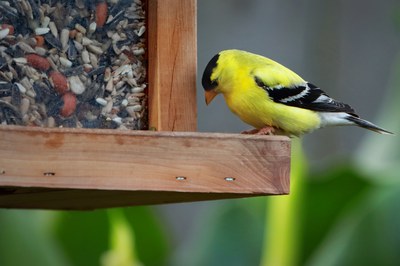
Would you like to get closer to nature? Put up a bird feeder.
Birds are wonderful to watch, especially in winter. Our feathered friends provide bright flashes of color, wonderful songs and curious movements. It’s a fun activity for everyone in the family.
Now is the time to take action. The weather is getting cold outside and birds are looking for a place to stay warm. Here are a few tips:
Provide good food. This is the most critical factor. Birds won’t visit your station if they do not like the food you offer. Black-oil sunflower and white proso millet seeds are highly desired by most birds. These seeds are rich in calories, which birds need to stay warm, and provide the best value.
Cracked corn and safflowers are useful additions to a seed mix. Niger thistle is preferred by goldfinches and house finches. Blue jays love peanuts.
Avoid seed mixes with wheat, millet, oats and rice. Birds pick through these inexpensive mixes, making a mess on the ground below.
Feeding songbirds can get expensive. Make a commitment to feed birds all winter or don’t feed them at all. Birds are especially vulnerable to hunger in late winter, when food sources in nature are most lacking. Buy seed in bulk to save money.
Get a variety of feeder boxes. A traditional wooden feeder mounted on a pole (see photo) will attract most birds. This feeder typically has a wooden roof and a clear plastic hopper that sits upon a shelf used by hungry birds for perching. The seeds drop down to the birds by gravity. This popular feeder is the best feeder to select if you use only one.
You can attract a wider variety of birds by adding other feeders. Nylon-covered wire cages filled with suet will attract woodpeckers and chickadees. Hanging tube feeders will attract finches.
Keep it safe. Birds won’t come to your station if they feel it is a dangerous place. Mount your feeders at least 5 feet high to discourage cats and other predators. Some type of cover, such as trees or shrubs, should be within 5 feet. This cover will provide a place of sanctuary for birds when threatened by predators.
Get a front-row seat. Place the feeder near a window where you can comfortably sit and watch the birds.
Millions of birds die from flying into windows every year. Place the feeder within 3 feet of a window or more than 30 feet away from a window. Birds that strike a window from a short distance are less likely to get harmed.
Give them water. All creatures need water to survive. Choose a bath with a rough surface and gentle slope, and one that is no more than 2 to 3 inches deep. Add branches or stones that emerge from the water to let birds drink without getting wet. Keep the bath full. Thermostatically controlled heaters will keep water from freezing.
Invite songbirds to your yard this winter. You and the birds will feel warm and happy.
To learn more about establishing a successful bird feeding station, go to https://feederwatch.org.
Written by Tom Kalb, Extension Horticulturist, NDSU. Edited by Ellen Crawford, NDSU Agriculture Communication. Photo courtesy of Ian Sane. Source: Bird feeding - Tips for beginners and veterans. University of Wisconsin: Madison.
How to Select a Crabapple
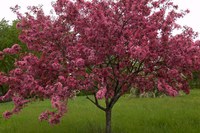 |
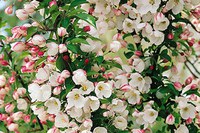 |
| 'Adams' | 'Adirondack' |
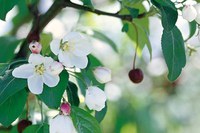 |
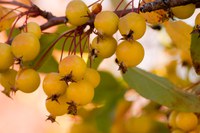 |
| 'Donald Wyman' | 'Harvest Gold' |
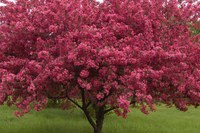 |
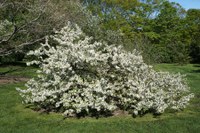 |
| 'Prairifire' | 'Sargent' |
One of the most beautiful sights in spring is a blooming crabapple. They are spectacular!
It’s no wonder the crabapple is the favorite small tree in North Dakota. If you go to a garden center, you will find lots of different crabapple cultivars available.
Which one is best for you? Here are some tips to help you make a choice.
Hardiness. This is always the first consideration when selecting a tree. It makes no sense to buy a tree that will die over winter. All crabapple cultivars discussed in this article are hardy to Zone 4. If you live in the far northern area of the state, focus on cultivars hardy to Zone 3.
Flower Color. This is usually the key factor. Pink or white? Besides your personal color preference, keep in mind where the tree will be planted. What is the background? For example, a white-blossomed tree will be less showy if the background is a white building. Likewise, a tree with dark pink flowers may not contrast well against a red brick building.
Fruit Persistence. This is very important! Why do we focus so much on flower color? The flowers will remain on the tree for only a couple weeks. I encourage you to consider how long the fruits persist on the tree. Some cultivars have fruit that persist on the tree through much of the fall and winter, adding color to our landscapes for several months. Cultivars known for their persistent fruits include ‘Adams’, ‘Adirondack’, ‘Donald Wyman’, Harvest Gold®, ‘Prairifire’, ‘Profusion’, Red Jewel®, ‘Red Splendor’, Royal Raindrops®, ‘Sargent’ and Sugar Tyme®.
Fruit Size. Smaller is better. Larger fruits generally create bigger messes when they drop. Avoid cultivars with fruits that are 2/3 inch or larger in diameter. Pea-sized fruits are much less messy and often stay on the tree longer.
Lack of Fruit. For gardeners who hate the mess created by dropping fruits, sterile cultivars are available, namely Marilee® and ‘Spring Snow’. Sterile trees are most useful in patios and courtyards.
Fruit Color. We automatically think crabapple fruits are red, but some cultivars produce golden yellow fruits. That’s special. These cultivars include Cinderella®, Harvest Gold®, Lollipop® and ‘Louisa’.
Not all red fruits are the same. Some red fruits are dark and dull. Others are brilliant. Cultivars with the brightest fruits include ‘Adirondack’, ‘Donald Wyman’, Red Jewel® and ‘Sargent’.
Foliage Color. Trees with purple or bronze foliage will stand out and make an eye-catching statement in the landscape. These cultivars include ‘Cardinal’, Gladiator™, ‘Prairifire’, ‘Purple Prince’, ‘Royal Beauty’ and ‘Royal Raindrops®’.
On the other hand, a crabapple with green foliage can provide a more natural, relaxing effect in landscapes.
Tree Shape. Many cultivars have a rounded canopy, but some have upright to columnar canopies suitable for tight spaces. These include ‘Adirondack’, Gladiator™, Ivory Spear™ and ‘Marilee®’.
A few cultivars (‘Louisa’, ‘Royal Beauty’ and Ruby Tears™) have graceful, weeping habits; this can make a statement as a specimen tree in your landscape.
‘Sargent’ is a great choice if you are looking for a dwarf (8-foot-high) tree with a horizontal habit.
Resistance to Disease. Look for trees that resist diseases. It’s heart-breaking to have a crabapple tree that drops its leaves in mid-summer due to scab disease or dies prematurely from fire blight. Scab is more of a problem in the eastern part of our state because of its higher humidity.
More Information. Look over the online charts of Johnson’s and J. Frank Schmidt nurseries. Most local nurseries get their products from Bailey Nursery. Go to their website, type in “crabapple”; and learn about their selections.
Crabapple cultivars have been reviewed by NDSU researchers for decades. The authoritative publication that describes their work is Choice Flowering Crabapple Cultivars for the Northern Plains.
The following chart is a summary of the some of the finest crabapple cultivars for North Dakota. Available as PDF.
| CULTIVAR | ZONE | H | W | SHAPE | FOLIAGE | FLOWER | FRUIT | SCAB | FIREB |
| Adams | 4 | 20 | 20 | Rounded | Green | Pink | Red; 5/8"; persistent | Good | Excel. |
| Adirondack | 4 | 18 | 12 | Upright | Green | White | Bright red; 1/2"; abundant; persistent | Excel. | Exc. |
| Cardinal | 4 | 15 | 20 | Spreading | Dark red, glossy | Deep pink-red | Deep red; 1/2" | Excel. | Good |
| Cinderella® | 4 | 8 | 5 | Oval | Dark green, cut | White | Yellow; 1/4"; persistent | Fair | Excel. |
| Donald Wyman | 4 | 20 | 25 | Rounded | Green, glossy | White | Bright red; 3/8"; abundant; persistent | Good | Fair |
| Firebird® | 4 | 10 | 10 | Rounded | Dark green | White | Bright red; 3/8"; persistent | Excel. | Excel. |
| Gladiator™ | 2 | 20 | 9 | Upright | Bronze-purple | Bright pink | Red-purple; small | Good | Good |
| Harvest Gold® | 4 | 20 | 20 | Rounded | Dark green | White | Gold; 1/2"; persistent | Fair | Fair |
| Ivory Spear™ | 4 | 18 | 7 | Narrow | Dark green | White | Bright red; 1/2" | Excel. | Excel. |
| Lollipop® | 4 | 10 | 10 | Rounded | Green | White | Gold-yellow; 3/8" | Good | Good |
| Louisa | 4 | 10 | 12 | Weeping | Dark green, glossy | Pink | Gold-yellow; 3/8" | Good | Good |
| Marilee® | 4 | 24 | 10 | Narrow | Green | Double white | Nearly sterile | Good | Good |
| Perfect Purple | 4 | 20 | 20 | Rounded | Deep purple | Deep pink-rose | Purple-red | Fair | Fair |
| Prairifire | 4 | 20 | 20 | Rounded | Ages to red-green | Bright magenta | Maroon; 1/2"; persistent | Excel. | Good |
| Profusion | 4 | 20 | 20 | Upright | Ages to bronze | Red-purple | Maroon; 1/2"; persistent | Fair | Good |
| Purple Prince | 4 | 20 | 20 | Rounded | Ages to bronze-green | Rose-red | Maroon; 1/2" | Excel. | Good |
| Red Jewel® | 4 | 15 | 12 | Upright | Dark green | White | Bright red; 1/2"; persistent | Good | Fair |
| Red Splendor | 3 | 23 | 20 | Upright | Ages to green | Bright pink | Bright red; 1/2"; persistent | Good | Fair |
| Royal Beauty | 3 | 10 | 8 | Weeping | Purple | Dark pink | Dark red; 1/2"; persistent | Good | Excel. |
| Royal Raindrops® | 4 | 20 | 15 | Upright | Purple, cutleaf | Bright pink-red | Red; 1/4"; persistent | Excel. | Good |
| Ruby Dayze® | 4 | 22 | 16 | Upright | Ages to bronze | Bright magenta | Deep red; 1/4" | Excel. | Excel. |
| Ruby Tears™ | 4 | 8 | 13 | Weeping | Burgundy-green | Pink | Dark red; 3/8" | Good | Excel. |
| Sargent | 4 | 8 | 12 | Horizontal | Dark green | White | Bright red; 1/4; abundant; persistent | Excel. | Excel. |
| Show Time™ | 3 | 22 | 20 | Rounded | Bronze-green | Bright pink-red | Red; 1/2" | Fair | Good |
| Spring Snow | 4 | 25 | 20 | Oval | Bright green | White | Nearly sterile | Poor | Fair |
| Sugar Tyme® | 4 | 18 | 15 | Oval | Green | White | Red; 1/2"; persistent | Excel. | Good |
| Tina | 4 | 6 | 8 | Rounded | Dark green, small | White | Bright red; 1/4" | Excel. | Good |
Written by Tom Kalb, Extension Horticulturist, North Dakota State University. Photos courtesy of keeva999 (home page), Bailey Nursery and Plant Image Library.
Information from the above chart was obtained from similar charts from Johnson's Nursery and J. Frank Schmidt and information from Bailey Nursery.
Most local nurseries get their products from Bailey Nursery. Learn about all of their selections.
Easy Ways to Improve Your Landscape
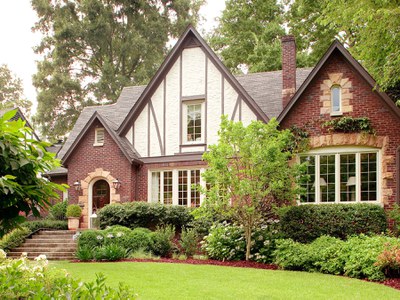 Don Kinzler, Horticulture Educator in Cass County, recently shared his insights on how to turn existing plantings into eye-catching landscapes.
Don Kinzler, Horticulture Educator in Cass County, recently shared his insights on how to turn existing plantings into eye-catching landscapes.
Don's discussed how to create a focal point near the front entry, rejuvenate old shrubs, widen plant beds, use curved edges for beds, add low-growing trees along the perimeter, and much more.
Download his full list of tips.
Photo courtesy of Don Kinzler.
The Toughest Shrubs
Do you need to select a tough shrub for your yard? Don’t go to your local garden center for inspiration. Go to the nearest gas station.
Gas stations are where plants go to die. Shrubs at gas stations are totally neglected. They are never watered and are surrounded by heat-trapping rock mulch. The air is polluted, and the soil is soaked with gas and salt. Shrubs at gas stations are never pruned—usually they die first.
Any shrub that can survive at a gas station can survive in your landscape. The next time you fill up your car’s gas tank, take a moment to see if any of the plants nearby are surviving. You likely will see one of these rugged shrubs:
The toughest shrub may be Japanese barberry (shown). These durable plants come in a wide range of colors including purple, yellow and green. Barberry can withstand heat, drought and poor soil. Its stems have sharp spines that make it deer-proof. Some scientists classify barberry as an invasive "weed," but that is not always a bad quality. It's hardy to Zone 4.
A rugged shrub with beautiful flowers is potentilla (shown). Its bright golden flowers adorn the shrub all summer long. Native to our area, it thrives in our harsh climate.
Pink-flowering spireas (shown) are tough plants. Some spireas have green leaves while others have gold leaves. The most vigorous varieties have dark green leaves. These leaves are packed full of chlorophyll, which produces energy for plants. Keep in mind that gold-leaf spirea and other gold-leaf shrubs don’t have as much chlorophyll and are naturally weaker. Spireas are hardy to Zone 4.
If you need a hardy shrub with purple leaves, a great choice is ‘Diabolo’ ninebark. It’s tough as nails.
If fruits are important to you, consider aronia (a.k.a. chokeberry) (shown). It is pest-free, grows quickly, bears blueberry-like fruits (unfortunately they taste bitter), and has radiant red fall color.
Everyone loves roses, but most roses require lots of maintenance. Consider the rugosa rose (shown). These plants tolerate heat, drought, salt and wind—hey, that makes them perfect for us in North Dakota! Some varieties bloom all summer and have scarlet rose hips in winter. Popular selections include Blanc Double de Coubert (white), Therese Bugnet (pink), Lotty’s Love (purple) and Fru Dagmar Hartopp (light pink).
If you need an evergreen, nothing is tougher than junipers (shown). These rugged shrubs are hardy, tolerate drought and will survive in saline soils.
These “gas station plants” can survive the most brutal conditions your landscape can offer. But don’t treat your landscape like a gas station. Show a bit of love to your plants and they’ll reward you many times over.
Written by Tom Kalb, Extension Horticulturist, North Dakota State University. Photos courtesy of Proven Winners, www.provenwinners.com; Joanna Dubaj from Pixabay; and Jan Haerer from Pixabay.
Tough Tree Gains Popularity
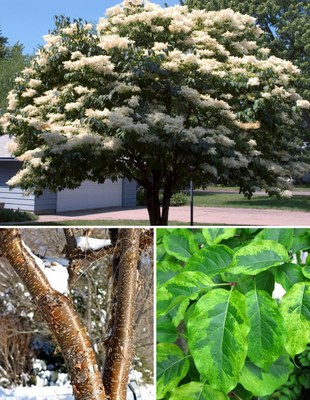
The Japanese tree lilac (Syringa reticulata) is one of the toughest and most trouble-free trees for landscapes. It offers year-round beauty with its showy blooms, emerald leaves and glossy bark.
Japanese tree lilac is hardy throughout the state and adapts well to our soils. It is one of the finest trees to grow along boulevards. The rounded canopy grows 25 feet tall and fits neatly under power lines.
When the spring blooms of crabapples and lilacs have faded, the Japanese tree lilac takes center stage with its late display of cream-colored flowers. The fragrance of the flowers is not very pleasing; but not stinky either. Some gardeners feel the flowers smell like privet. Less critical gardeners say the blooms smell like vanilla.
The glossy copper bark is a great feature that provides winter interest.
‘Ivory Silk’ has been the top variety since its introduction from Ontario in 1973. It is a sturdy tree with deep green leaves. It blooms at a young age and is known for its heavy set of blooms. First Editions Snowdance™ has similar features (Fig. 1), and it has sterile flowers that won’t create messy seedheads.
‘Golden Eclipse’ offers variegated foliage in spring, making this remarkable tree even more special. Its variegation fades over summer.
Written by Tom Kalb, Extension Horticulturist, North Dakota State University. Photos were made available under Creative Commons licenses specified by the photographers: Bailey Nurseries, Inc.; Minnesota Tree Resources; and Mark Dwyer.
Boxelder bugs are swarming
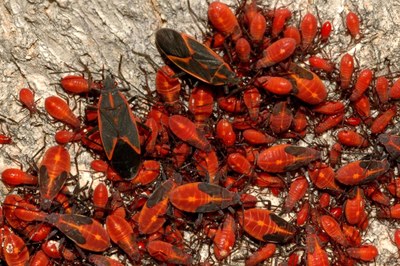 The redcoats are coming! The redcoats are coming!
The redcoats are coming! The redcoats are coming!
With apologies to Paul Revere, swarms of red-coated boxelder bugs are marching toward our homes.
Adult boxelder bugs are large black insects with reddish-orange markings on their wings (see photo). The immature nymphs have red as their dominant color.
These bugs spent summer sipping on the sap of soft-wooded maples, including silver and boxelder maples. They didn’t damage the trees and most of us did not notice them.
But the warm, carefree days of summer are over and the bugs are desperately looking for heat. You can find them sunning themselves on the south- and west-facing sides of homes.
Boxelder bugs are fairly harmless. They don’t breed indoors and they won’t eat your food. They won’t bite your toes and they won’t eat your furniture. They are just looking for a warm place to spend the winter.
You can leave them alone and after a few hard frosts the problem is over.
If the bugs are causing you a major nuisance, consider spraying them with detergent. Mix three to five tablespoons of liquid detergent per gallon of water. Detergent sprays kill bugs that are sprayed upon and have no residual effect. Repeated detergent sprays will be necessary.
For severe infestations, toxic insecticides can be sprayed on and around the foundation of the home. Insecticides with synthetic pyrethroids are recommended since they work under cool temperatures. These include permethrin, cyfluthrin, and esfenvalerate.
The best defense is to “pest-proof” your home. Caulk any cracks along the foundation, doors or windows. Seal openings where utility cables enter the home. Screen any vents, and apply weather stripping on doors.
Any boxelder bugs that enter your home can be swept outside or vacuumed. Avoid squishing the bugs because their “juices” can stain fabrics. If vacuuming, empty the dust bag immediately to prevent bugs from escaping out of the vacuum.
Photo courtesy of William M. Ciesla, Forest Health Management International, Bugwood.org.
Discover diervilla
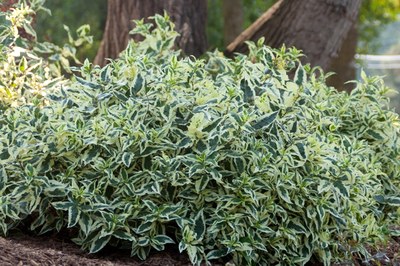
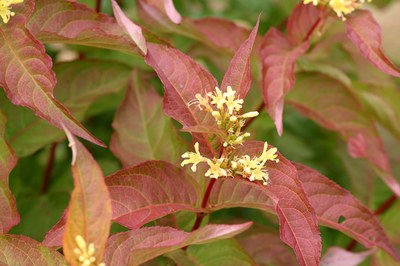
There is a new plant appearing in North Dakota landscapes and it is grabbing a lot of attention. It's diervilla (Diervilla sessilifolia). I've never heard of it before—have you?
Originally considered nothing more than a tough shrub for riverbanks and roadsides, new selections of diervilla are generating excitement across the nation.
Michael Dirr, one of the most respected woody ornamentals experts in the USA, originally dismissed diervilla but now admits he was wrong. Start with First Editions® Cool Splash® (top photo). Dirr states Cool Splash® definitely has the “wow factor!” The creamy white and green variegated leaves are bright, clean and do not burn. Cool Splash® is hardy to Zone 3.
Proven Winners Kodiak™Orange diervilla is just as special but in a much different way. Its orange-red hues glow in fall (bottom photo) and rival the beauty of burning bush. It is hardy to Zone 4.
Diervilla has light yellow flowers that attract bees and butterflies in summer. It is a thick, suckering shrub that grows 3–4 feet high and spreads 4–5 feet wide. Diervilla seems well-suited to grow in masses in low-maintenance, naturalized settings. It is resistant to deer.
Dirr reports diervilla is a “tremendously tough” plant that is tolerant to winds and drought. This sounds great for us in North Dakota!
Cool Splash® can be planted in sun but is often used as an understory plant in partial shade, where its white leaf tones are bright and dramatic. It makes sense to plant Kodiak™Orange in full sun where it develops its optimal fall color.
Diervilla is a tough shrub with striking beauty. Look for these and other hardy selections of diervilla in the future.
Written by Tom Kalb, Extension Horticulturist, North Dakota State University. Photos courtesy of Bailey Nurseries, Inc. and Proven Winners. This article was originally published in the NDSU Yard & Garden Report, September 2, 2015. Source used for this article: Dirr, M.A, 2009. Manual of woody landscape plants. 6th ed. Stipes Publishing: Champaign, IL.





